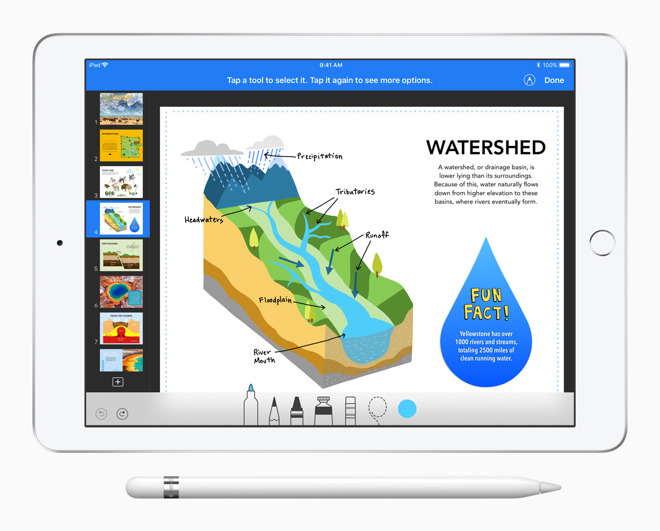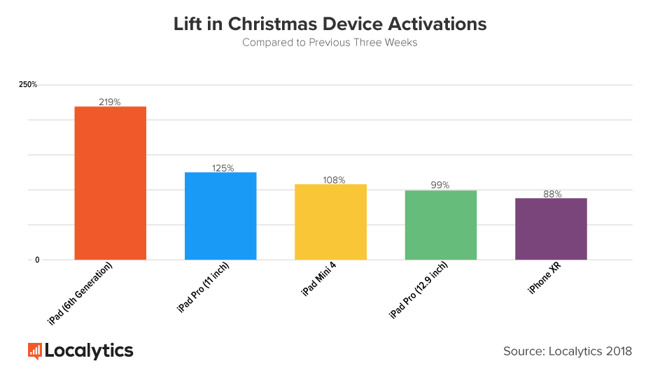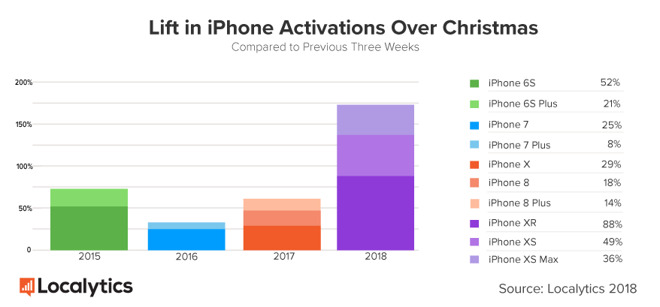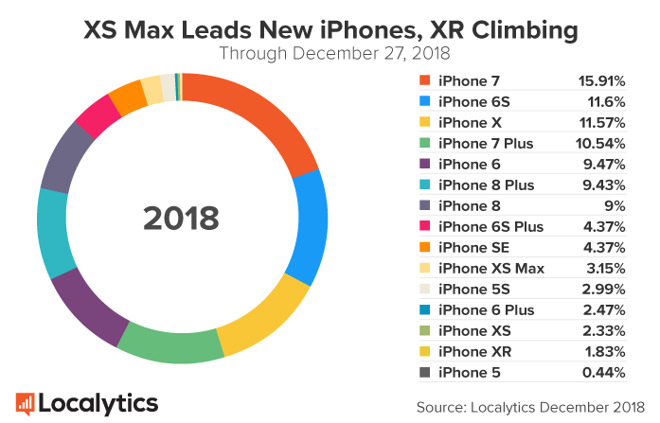iPads & iPhone XR lead in Christmas activations, helping XR catch up to XS in market share...
iPad activations surged the most among all phones and tablets during the Christmas holiday, dominating the top four spots -- fifth place being taken by another Apple product, the iPhone XR, according to new analytics data.

Leading the pack was the 2018 "budget" iPad, which saw activations rise 219 percent versus the previous three weeks, Localytics said. This was fueled by deals at retailers like Amazon, Target, and Walmart, which took $100 off 32-gigabyte models and $80 off 128-gigabyte configurations. Apple normally charges $329 and $429 respectively.
Some stores also offered cuts for new 11-inch and 12.9-inch iPad Pros, which saw their activations jump 125 and 99 percent. Those discounts likely had a mild effect, given that even a 64-gigabyte 11-inch Pro was at least $759, $10 more than an iPhone XR. Pros typically start at $799.

The 12.9-inch Pro was surpassed by the iPad mini 4, despite the latter being over three years old, and at $399 (from Apple) actually more expensive than the entry-level budget iPad. That price does include 128 gigabytes of storage though, and third-party retailers have been selling it for less.
iPhone XR activations increased 88 percent, Apple's greatest surge in Christmas iPhone adoptions during the past three years. Localytics did note that the XR only began shipping October, whereas the XS and XS Max arrived a month earlier.

The XR's share of the overall iPhone market grew to 1.83 percent. That's modestly close to the 2.33 percent controlled by the XS, if still distant of the XS Max's 3.15 percent.

The last time iPads topped Christmas activations was in 2016. 2017 was led by Google's Pixel 2 and Pixel 2 XL, with the iPhone X, 8, and 8 Plus filling out the top five.

Leading the pack was the 2018 "budget" iPad, which saw activations rise 219 percent versus the previous three weeks, Localytics said. This was fueled by deals at retailers like Amazon, Target, and Walmart, which took $100 off 32-gigabyte models and $80 off 128-gigabyte configurations. Apple normally charges $329 and $429 respectively.
Some stores also offered cuts for new 11-inch and 12.9-inch iPad Pros, which saw their activations jump 125 and 99 percent. Those discounts likely had a mild effect, given that even a 64-gigabyte 11-inch Pro was at least $759, $10 more than an iPhone XR. Pros typically start at $799.

The 12.9-inch Pro was surpassed by the iPad mini 4, despite the latter being over three years old, and at $399 (from Apple) actually more expensive than the entry-level budget iPad. That price does include 128 gigabytes of storage though, and third-party retailers have been selling it for less.
iPhone XR activations increased 88 percent, Apple's greatest surge in Christmas iPhone adoptions during the past three years. Localytics did note that the XR only began shipping October, whereas the XS and XS Max arrived a month earlier.

The XR's share of the overall iPhone market grew to 1.83 percent. That's modestly close to the 2.33 percent controlled by the XS, if still distant of the XS Max's 3.15 percent.

The last time iPads topped Christmas activations was in 2016. 2017 was led by Google's Pixel 2 and Pixel 2 XL, with the iPhone X, 8, and 8 Plus filling out the top five.

Comments
The new iPad Pro is amazing to hold, so light and thin, it’s great. On the list for someday.
Then theres the Apple program where this year’s upgrade is costing me an additional $5 per month.....
The current models are no more expensive than last years.
In addition to being environmentally sound, not being so hardware-focused means that users will be pointed to -- and rely on -- services more for "new tricks" as they keep their iPhones for 3-4 years, and services are much more profitable than hardware. This is, I think, Apple's answer to the end of subsidies, and over the long term it is a very good answer (credit to Google for thinking of it first, but minus points for basing their services on spyware datamining).
While I am about to upgrade my iPhone 6s (finally) later this year, it has served me extremely well and is still in great shape, and will be 3.5 years old when I replace it -- and the nice thing is that I don't have to replace it. I'm upgrading strictly for esoteric reasons (aka portrait mode and animoji) rather than need, and if a sudden expense waylays my plan, I can easily see myself holding onto this 6s till September to see what entices me. It does everything I need it to do, very well (one low-cost battery replacement later, of course).
I see a LOT of people with 6s and even 5s iPhones around still (much more beaten up than mine) and when I query them, most seem to be only just now thinking about an upgrade for maybe next Christmas. I can only imagine that many iPhone 8 or X owners won't be seriously shopping until the fall of 2020.
Given the almost-certain coming recession, Apple timed this rollout of "phones you don't have to trash after two years" just right IMO -- plus the strong OS, battery, and other support Apple gives its iPhones over four to five years makes this shift actually a factor that I think will result in even more Android switchers, since I suspect the majority of Android users would jump ship if they were sure their investment in a premium smartphone would result in them still having it three, four, even five years later.
In that context, the latest iPhones seem much more affordable to me* than the various models I swapped out every two years like clockwork previously.
* And countries that still have subsidies and contracts -- well you're getting the best of both worlds aren't you?